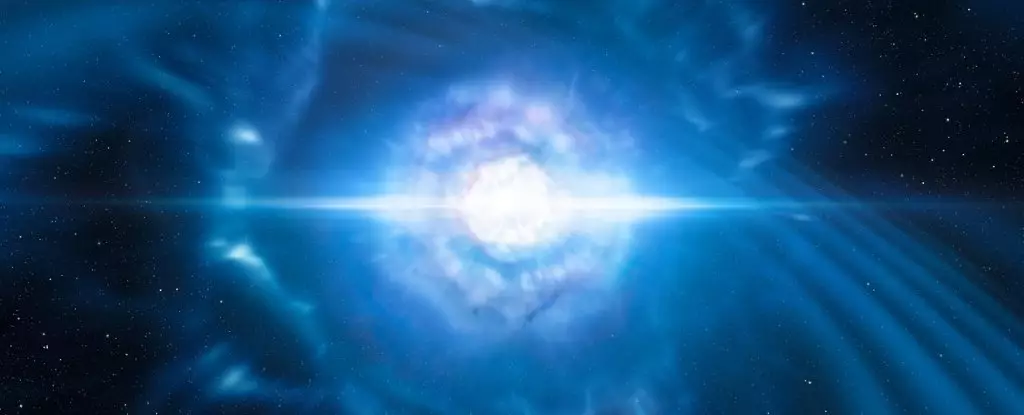In the realm of astrophysics, few events have captivated scientists and stargazers alike as much as the collision of two neutron stars on August 17, 2017. This monumental event, known as AT2017gfo, represented not only a spectacular merger of dense cosmic entities but also a groundbreaking moment in our understanding of the universe. The collision sent ripples through space-time that resonated across our planet, detected by gravitational wave observatories like LIGO and Virgo. These oscillations heralded an explosion that illuminated our telescopes, providing an unprecedented opportunity to observe the birth of heavy elements and contributing vital data for years to come.
The implications of this discovery extend far beyond the immediate spectacle of a kilonova. It offers a glimpse into the processes that forge the elements necessary for our existence. The merging neutron stars birthed a cosmic fireball that released a torrent of energy, propelling heavy elements into the universe. Researchers theorized that such events could give rise to elements heavier than iron—stuff that forms the building blocks of planets and all life.
Astrophysicist Albert Sneppen and his research team at the Niels Bohr Institute have dedicated their efforts to unraveling the layers of complexity surrounding this cosmic event. The study’s findings reveal that the evolution of AT2017gfo is akin to moments leading up to the Big Bang, where a seething mass of particles born from the collision cooled and eventually coalesced into stable matter. The intricate choreography of these particles—as they moved and transformed within the expanding fireball—reflects a process that scientists have sought to understand through various telescopes positioned around the globe.
Each telescope provided a unique viewpoint, revealing select aspects of the event’s evolution. However, as Sneppen points out, no single perspective could narrate the entire story due to the constraints of Earth’s rotation. Yet their team faced this challenge head-on, investing time in harmonizing the data sourced from facilities in Australia, South Africa, and the Hubble Space Telescope. By stitching together these disparate observations, they meticulously reconstructed a timeline that captured the dramatic changes occurring within the kilonova over a span of hours—a feat that highlights the unity of observational strategies in modern astrophysics.
From Plasma to Atoms: A Cosmic Rebirth
Among the many revelations brought forth by the AT2017gfo observations was the direct evidence of the creation of heavy elements such as strontium and yttrium. Traditionally, the forging of elements heavier than iron was attributed to supernova explosions. The kilonova’s revelation veers away from this notion, indicating that neutron star collisions are equally vital to the cosmic element production line.
This remarkable fireball, reaching temperatures of billions of degrees during its initial moments, offered a primordial environment reminiscent of the early universe. Here, electrons and other elementary particles danced in a sea of energy, unbound by conventional forces. As the kilonova expanded and cooled, these particles began to lock together, resulting in the formation of atoms. This sequence of events closely mirrors the Epoch of Recombination from the early universe, an era occurring approximately 380,000 years post-Big Bang when the universe finally allowed light to pass freely for the first time.
The implications of these findings underscore a revolutionary aspect of astrophysics; neutron star kilonovae could serve as miniature laboratories for studying the dynamics of the early universe. The unique ability to observe atomic formation in such distant explosions allows researchers to probe micro-physics in unprecedented ways. Rasmus Damgaard, also from the Niels Bohr Institute, emphasizes that this observation enables scientists to witness firsthand the confluence of atomic nuclei and electrons as they come together to form matter.
This exciting realm of study further allows us to witness the universe’s history and the interactions that led to the creation of the elements we encounter today. By observing the kilonova from several vantage points, researchers gain invaluable insight into the fundamental processes that shape our cosmos. Indeed, amidst the majestic function of birth and destruction in the universe, we are confronted with a profound understanding of our own origins.
In the grand tapestry of the universe, events like AT2017gfo serve as powerful reminders of how interconnected our existence is with the larger cosmos. It beckons us to explore deeper, as we strive to grasp the forces that fuel the stars—and in turn, the processes that brought us here. Each finding adds another thread to the narrative, igniting curiosity and illuminating the path forward in our quest for knowledge.


Leave a Reply